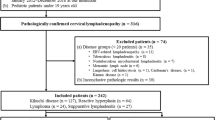Abstract
The aim of this study was to identify clinical factors that can predict malignancy in patients with persistent cervical lymphadenopathy. This retrospective study included 575 patients with persistent cervical lymphadenopathy who underwent surgical excision. The patients were divided into two groups according to their ages: group 1 (≤18 years) and group 2 (>18 years). Multiple logistic regression models and univariate analysis were performed to determine the association between clinical factors and malignancy. Male gender [odds ratio (OR) 4.184, 95 % confidence interval (CI) 1.823–9.602, p = 0.001], increased age (OR 1.072, 95 % CI 1.001–1.148, p = 0.046), left-sided lesions (OR 3.423, 95 % CI 1.407–8.329, p = 0.007), and larger lymph node size (OR 1.445, 95 % CI 1.021–2.044, p = 0.038) were significantly associated with malignancy in group 1. Male gender (OR 3.761, 95 % CI 2.361–5.992, p = 0.001), increased age (OR 1.015, 95 % CI 1.003–1.027, p = 0.018), duration of the disease (OR 0.770, 95 % CI 0.668–0.888, p = 0.001), and the presence of B symptoms (OR 4.996, 95 % CI 2.862–8.721, p = 0.001) were significantly associated with malignancy in group 2. The sensitivity and specificity of the models were 84 and 61.5 % for group 1 and 77.9 and 67.9 % for group 2, respectively. Increasing age and male gender were found to be associated with malignancy in all age groups. Larger lymph node size and left-sided lymphadenopathy were significant predictors of malignancy in children. Presence of B symptoms was found to be associated with malignancy in adults. Our results indicated that increasing duration of lymphadenopathy and the presence of bilaterality render the lymph node more likely to be benign in adults. No significant association was found between the involved neck site and malignancy for all age groups.



Similar content being viewed by others
References
Allhiser JN, McKnight TA, Shank JC (1981) Lymphadenopathy in a family practice. J Fam Pract 12:27–32
Fijten GH, Blijham GH (1988) Unexplained lymphadenopathy in family practice. An evaluation of the probability of malignant causes and the effectiveness of physicians’ workup. J Fam Pract 27:373–376
Nolder AR (2013) Paediatric cervical lymphadenopathy: when to biopsy? Curr Opin Otolaryngol Head Neck Surg 21:567–570
Laffers W, Eggert K, Schildhaus HU, Bootz F, Gerstner AO (2012) Histologic diagnoses in persistently swollen cervical lymph nodes. Head Neck 34:371–375
Ingolfsdottir M, Balle V, Hahn CH (2013) Evaluation of cervical lymphadenopathy in children: advantages and drawbacks of diagnostic methods. Dan Med J 60:A4667
Moore SW, Schneider JW, Schaaf HS (2003) Diagnostic aspects of cervical lymphadenopathy in children in the developing world: a study of 1,877 surgical specimens. Pediatr Surg Int 19:240–244
Locke R, Comfort R, Kubba H (2014) When does an enlarged cervical lymph node in a child need excision? A systematic review. Int J Pediatr Otorhinolaryngol 78:393–401
Khillan R, Sidhu G, Axiotis C, Braverman AS (2012) Fine needle aspiration (FNA) cytology for diagnosis of cervical lymphadenopathy. Int J Hematol 95:282–284
Bhattacharyya N (1999) Predictive factors for neoplasia and malignancy in a neck mass. Arch Otolaryngol Head Neck Surg 125:303–307
Al Kadah B, Popov HH, Schick B, Knöbber D (2015) Cervical lymphadenopathy: study of 251 patients. Eur Arch Otorhinolaryngol 272:745–752
Tsai JG, Chiang SC, Lin CZ, Chang P (1992) Predicting probability of malignancy of neck mass with logistic regression model: a statistical analysis of excisional biopsy of neck masses. Chung Hua I Hsueh Tsa Chih 49:328–334
Chau I, Kelleher MT, Cunningham D, Norman AR, Wotherspoon A, Trott P, Rhys-Evans P, Querci Della Rovere G, Brown G, Allen M, Waters JS, Haque S, Murray T, Bishop L (2003) Rapid access multidisciplinary lymph node diagnostic clinic: analysis of 550 patients. Br J Cancer 88:354–361
Wang J, Pei G, Yan J, Zhao Q, Li Z, Cao Y, Li J, Zhang G, Chen H, Hao X (2010) Unexplained cervical lymphadenopathy in children: predictive factors for malignancy. J Pediatr Surg 45:784–788
Matsumoto F, Itoh S, Ohba S, Yokoi H, Furukawa M, Ikeda K (2009) Biopsy of cervical lymph node. Auris Nasus Larynx 36:71–74
Karaman A, Karaman I, Cavuşoğlu YH, Erdoğan D (2010) The ongoing problem with peripheral lymphadenopathies: which ones are malignant? Pediatr Surg Int 26:247–250
Soldes OS, Younger JG, Hirschl RB (1999) Predictors of malignancy in childhood peripheral lymphadenopathy. J Pediatr Surg 34:1447–1452
Celenk F, Baysal E, Aytac I, Durucu C, Sari I, Mumbuc S, Kanlikama M (2013) Incidence and predictors of malignancy in children with persistent cervical lymphadenopathy. Int J Pediatr Otorhinolaryngol 77:2004–2007
Author information
Authors and Affiliations
Corresponding author
Ethics declarations
Conflict of interest
No conflict of interest.
Rights and permissions
About this article
Cite this article
Celenk, F., Gulsen, S., Baysal, E. et al. Predictive factors for malignancy in patients with persistent cervical lymphadenopathy. Eur Arch Otorhinolaryngol 273, 251–256 (2016). https://doi.org/10.1007/s00405-015-3717-3
Received:
Accepted:
Published:
Issue Date:
DOI: https://doi.org/10.1007/s00405-015-3717-3




